Advertisement
Advertisement
Jagdish Mahto
About me:
I haven't shared any details about myself.
About my family:
I haven't shared details about my family.
Interested in the last names:
I'm not following any families.
Updated: January 19, 2023
Message Jagdish Mahto
Loading...one moment please


Recent Activity
Jagdish Mahto
updated a photo
Jan 19, 2023 3:34 AM
Jagdish Mahto
tagged a photo
Jan 19, 2023 3:32 AM
Jagdish Mahto
tagged a photo
Jan 19, 2023 3:32 AM
Jagdish Mahto
updated a photo
Jan 19, 2023 3:32 AM
Jagdish Mahto
shared a photo
Jan 19, 2023 3:29 AM
Freedom Fighter Raghunath Mahto
Raghunath Mahto was born on 21 March 1738 in...
Raghunath Mahto was born on 21 March 1738 in...
Photos Added
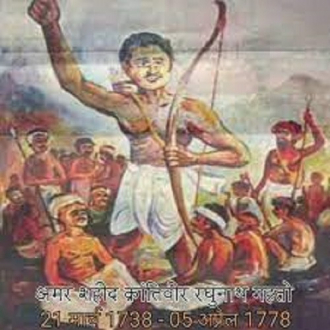
Freedom Fighter Raghunath Mahto
Raghunath Mahto was born on 21 March 1738 in ghutiadih village of Nimdih block of Saraikela Khorsoya District.[8][9][10]
The Rebellion against British was known as Chuar rebellion. Chuar means looter. When British started to collect taxes in 1765 when they won Battle of Buxar and got rights to collect taxes from Bihar and Bengal.[11] But people opposed it as People thought British were depriving their rights. Some Jamindar joined British while other rebeled against them. In 1769, Raghunath Mahato led Kudmi Mahato people against British.[12][6] His slogan was:
... "Apna Gaon, Apna Raj; Dur Bhagaw Bideshi Raj". [13][14]
The folklore sing by Lodha people is like:[15][16][17]
... "Kesu Aarir Fansi hailo, Raghunath Mahto Bandaigelo, Bansbone Dom hailo Kana, Rage Jalchche Jangal Mahal Thana."
When British asked the Jamindar about identity of rebels, Jamindar said the rebelious people are Chuar means looter, thieves, nasty people, barbarian, uncivilized, and arrogant.[18][19][20] The people who rebeled were belongs to many ethnic groups such as Kudmi Mahato,[21][22][23][11][24][25] Bagdi, Bhumij, Bauri, and other communities.
On 5 April 1778, Raghunath Mahato and his team who were planning to snacht weapons of British forces in forest. In this skirmish Raghunath Mahato and several other rebel died fighting British forces
The Rebellion against British was known as Chuar rebellion. Chuar means looter. When British started to collect taxes in 1765 when they won Battle of Buxar and got rights to collect taxes from Bihar and Bengal.[11] But people opposed it as People thought British were depriving their rights. Some Jamindar joined British while other rebeled against them. In 1769, Raghunath Mahato led Kudmi Mahato people against British.[12][6] His slogan was:
... "Apna Gaon, Apna Raj; Dur Bhagaw Bideshi Raj". [13][14]
The folklore sing by Lodha people is like:[15][16][17]
... "Kesu Aarir Fansi hailo, Raghunath Mahto Bandaigelo, Bansbone Dom hailo Kana, Rage Jalchche Jangal Mahal Thana."
When British asked the Jamindar about identity of rebels, Jamindar said the rebelious people are Chuar means looter, thieves, nasty people, barbarian, uncivilized, and arrogant.[18][19][20] The people who rebeled were belongs to many ethnic groups such as Kudmi Mahato,[21][22][23][11][24][25] Bagdi, Bhumij, Bauri, and other communities.
On 5 April 1778, Raghunath Mahato and his team who were planning to snacht weapons of British forces in forest. In this skirmish Raghunath Mahato and several other rebel died fighting British forces
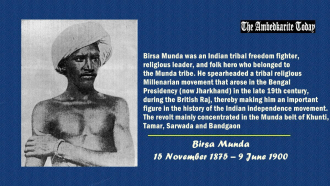
Birsa Munda
Birsa Munda The Dharthi Aba father of the earth
In raised over this ” Ulgulan ” (revolt), the then commissioner Mr. A fobes and Deputy Commissioner Mr. H.C. Streattfield, rushed to Kunti with two company of army to crush the mass struggle ( Ulgulan) of ” Abua Disun ” ( Self rule ).
The revolt had rocked the British administration to the extent that the commissioner declared a reward of Rs 500 for the arrest of Birsa. Subsequently British forces attacked heavily on Munda warriors congregated at ” Dumbari Hill ” and made indiscriminate firing like that of “Jaliyan Wala Bagh ” and killed several hundred people. The whole hill was littered with dead human corpses. After Brutal slaughter the dead bodies were thrown into the deep gorges and ravines of the hill .
Many of the wounded were buried alive . According to editorial published on march 25, 1900, the statesman , put the toll at 400. However , the then administration suppressed the fact and claimed that only eleven persons were killed and nine insured in two firings on January 7 and january 9, 1900. Fear and panic show spread over the area that “Dombari ” was named by munda’s as ” Topped Buru ” – mound of dead. Birsa Munda was nabbed while he was fast asleep at “Jamkopai ” forest in Chakradharpur on March 3, 1900.
Deputy commissioner Ranchi, vide letter no CR-1397 dated 12 nov 1900 reveals that 460 tribals were made accused in 15 different criminal cases, out of which 63 were convicted. One was awarded Capital Punishment , 39 were sentenced to transportation for life and 23 were imprisioned for terms upto 14 years. the six death , including that of tribal hero Birsa Munda in the prison during trials in less than 10 months, speaks of the probable tortures inflicted on the prisinors of Munda Ulgulan . Birsa Munda died in the jail on 9th June 1900.
Dead body of Birsa Munda is reported to have been criminated near the distillery bridge Kokar ( Ranchi ). People say, actually Birsa was buried under the bridge ( In 1900 there was no bridge). Though there is still no unanimous opinion of Birth and Death regarding date and Place of Birsa Munda yet Govt. has accepted that Birsa was born on 15 Nov 1875 in Ulihatu and died on 9 June 1900 in ranchi central jail. Birsa Munda was son of Sugna Munda. Sugna Munda has three sons namely- Kowa Munda , Birsa Munda and Bhanu Munda . Sugna Munda, father of Birsa Munda, had two more brothers namely- Bhanu Munda and Pasna Munda.
I am happy to associate myself with the unveiling of the statue of Shri Birsa Munda, a legendary figure in the history of our struggle for freedom. He is well known as an early advocate and exponent of tribal rights and as an indomitable fighter against foreign rule and oppression. One of the lesser-known aspects of our fight against British rule is that tribal uprisings constituted an important part of the defiance of the colonial regime. Birsa Munda is an outstanding representative of one such movement in late 19th century in Chotanagpur region, who initiated a unique phase of our freedom struggle … K.R. Narayanan, President of India
The birth of Jharkhand state, its limitations and compromises notwithstanding, is in a way a beginning of fulfillment of dream that the legendary Birsa Munda had dreamt more than 200 years ago. Long before, V I Lenin formulated the concept of Right of Nations to Self-Determination, Birsa Munda, had set out a theme for self-determination of one of the largest sub-nationalities , Jharkhand ,the land of the Adivasis or Jharkhandis. ” It was the first Long March, decades before the one led by Mao Ze Dong”, told Khudiram Pahan, a former Congress MLA and a trade union leader among tea estate workers in Dooars. Maybe, the saga of struggle waged by Munda had failed. But the candle he had lit never extinguishes.
There is an historical background too : the planned destruction of forest-based tribal society by the British colonialism whose main aim was to plunder and profit. There was an obvious retaliation by the Santhals who took up their last-ditch battle.The British Government reached the Santhal stronghold in the Chota Nagpur Plateau region. The simultaneous immigration of Hindu ‘diku’- the outsider, Christian missionaries, and British taxrevenue systems into the nineteenth-century District of Ranchi became a great burden for its provincial masses.
The santhal inhabitants were taken up by surprise when the British imposed their regulations on these
independent peace-loving tribals. This in due time led to friction between the tribals and British administration. The region soon flourished given its agricultural productivity. Merchants from Calcutta started trading along the river Bhagirathi. The British officials procured these output at very low prices, often bartering with just salt, tobacco and clothes. Gradually the artless Santhals started to get into a debt-trap. Eventually this led to loosing their land to the merchants and moneylenders. Thus with the setting-in of civilization along with the conquerors, the santhals started losing their only property – land.
Birsa Munda (1875-1900) or Birsa Bhagwan as he is known among his followers was a revolutionary who led his men to rise against the imperial government and its policies. He and his army would attacks the British regiments and landlords, armed with bows and arrows and reclaim what was taken away from them. For his bravery and wide support I the entire region, Birsa was a cause of distress for the British government.
The British army led several expeditions against him, when ultimately he was captured in 1900, by the deceit of his own men. Birsa died the same year in captivity, some say of cholera while others say in prison torment. At an age of 25, he claimed unmatched respect and reverence in his tribe. Birsa used the myths and symbols of his society and culture and became a rallying point for people to rise against foreign rule, oppression and injustice. His movement was also infused with the spirit of religious reform, social justice and cultural regeneration.
Birsa Munda became Christian while schooling in a Christian mission school at Burj. He was renamed as Daud. Instead of improving his life, Birsa Munda realised that his culture was destroyed and his life style came down. Because thousands of Mundas were converted, the great martyr Birsa Munda was aggrieved and rebelled against Christianity. He denounced Christianity and become Munda again. The colonialist connection of Christianity was a powerful tool of selling Christianity as the religion of the downtrodden. Any connection between the rulers and the missionaries was however indirect. “It is not only our duty,” declared Lord Palmerston, the Prime Minister, “but in our own interest to promote the diffusion of Christianity as far as possible throughout the length and breadth of India.” His fight against conversion was yet another reason the British were hunting for his head.
The districts around Ranchi is still the stronghold of santhals. The tribals still continue to be exploited even 50 years after Raj. ‘Diku’ in the local parlance means the outsider who exploited the inhabitants. Infact this particular region is fertile and at the same time one of the most mineral rich regions in the country.
In raised over this ” Ulgulan ” (revolt), the then commissioner Mr. A fobes and Deputy Commissioner Mr. H.C. Streattfield, rushed to Kunti with two company of army to crush the mass struggle ( Ulgulan) of ” Abua Disun ” ( Self rule ).
The revolt had rocked the British administration to the extent that the commissioner declared a reward of Rs 500 for the arrest of Birsa. Subsequently British forces attacked heavily on Munda warriors congregated at ” Dumbari Hill ” and made indiscriminate firing like that of “Jaliyan Wala Bagh ” and killed several hundred people. The whole hill was littered with dead human corpses. After Brutal slaughter the dead bodies were thrown into the deep gorges and ravines of the hill .
Many of the wounded were buried alive . According to editorial published on march 25, 1900, the statesman , put the toll at 400. However , the then administration suppressed the fact and claimed that only eleven persons were killed and nine insured in two firings on January 7 and january 9, 1900. Fear and panic show spread over the area that “Dombari ” was named by munda’s as ” Topped Buru ” – mound of dead. Birsa Munda was nabbed while he was fast asleep at “Jamkopai ” forest in Chakradharpur on March 3, 1900.
Deputy commissioner Ranchi, vide letter no CR-1397 dated 12 nov 1900 reveals that 460 tribals were made accused in 15 different criminal cases, out of which 63 were convicted. One was awarded Capital Punishment , 39 were sentenced to transportation for life and 23 were imprisioned for terms upto 14 years. the six death , including that of tribal hero Birsa Munda in the prison during trials in less than 10 months, speaks of the probable tortures inflicted on the prisinors of Munda Ulgulan . Birsa Munda died in the jail on 9th June 1900.
Dead body of Birsa Munda is reported to have been criminated near the distillery bridge Kokar ( Ranchi ). People say, actually Birsa was buried under the bridge ( In 1900 there was no bridge). Though there is still no unanimous opinion of Birth and Death regarding date and Place of Birsa Munda yet Govt. has accepted that Birsa was born on 15 Nov 1875 in Ulihatu and died on 9 June 1900 in ranchi central jail. Birsa Munda was son of Sugna Munda. Sugna Munda has three sons namely- Kowa Munda , Birsa Munda and Bhanu Munda . Sugna Munda, father of Birsa Munda, had two more brothers namely- Bhanu Munda and Pasna Munda.
I am happy to associate myself with the unveiling of the statue of Shri Birsa Munda, a legendary figure in the history of our struggle for freedom. He is well known as an early advocate and exponent of tribal rights and as an indomitable fighter against foreign rule and oppression. One of the lesser-known aspects of our fight against British rule is that tribal uprisings constituted an important part of the defiance of the colonial regime. Birsa Munda is an outstanding representative of one such movement in late 19th century in Chotanagpur region, who initiated a unique phase of our freedom struggle … K.R. Narayanan, President of India
The birth of Jharkhand state, its limitations and compromises notwithstanding, is in a way a beginning of fulfillment of dream that the legendary Birsa Munda had dreamt more than 200 years ago. Long before, V I Lenin formulated the concept of Right of Nations to Self-Determination, Birsa Munda, had set out a theme for self-determination of one of the largest sub-nationalities , Jharkhand ,the land of the Adivasis or Jharkhandis. ” It was the first Long March, decades before the one led by Mao Ze Dong”, told Khudiram Pahan, a former Congress MLA and a trade union leader among tea estate workers in Dooars. Maybe, the saga of struggle waged by Munda had failed. But the candle he had lit never extinguishes.
There is an historical background too : the planned destruction of forest-based tribal society by the British colonialism whose main aim was to plunder and profit. There was an obvious retaliation by the Santhals who took up their last-ditch battle.The British Government reached the Santhal stronghold in the Chota Nagpur Plateau region. The simultaneous immigration of Hindu ‘diku’- the outsider, Christian missionaries, and British taxrevenue systems into the nineteenth-century District of Ranchi became a great burden for its provincial masses.
The santhal inhabitants were taken up by surprise when the British imposed their regulations on these
independent peace-loving tribals. This in due time led to friction between the tribals and British administration. The region soon flourished given its agricultural productivity. Merchants from Calcutta started trading along the river Bhagirathi. The British officials procured these output at very low prices, often bartering with just salt, tobacco and clothes. Gradually the artless Santhals started to get into a debt-trap. Eventually this led to loosing their land to the merchants and moneylenders. Thus with the setting-in of civilization along with the conquerors, the santhals started losing their only property – land.
Birsa Munda (1875-1900) or Birsa Bhagwan as he is known among his followers was a revolutionary who led his men to rise against the imperial government and its policies. He and his army would attacks the British regiments and landlords, armed with bows and arrows and reclaim what was taken away from them. For his bravery and wide support I the entire region, Birsa was a cause of distress for the British government.
The British army led several expeditions against him, when ultimately he was captured in 1900, by the deceit of his own men. Birsa died the same year in captivity, some say of cholera while others say in prison torment. At an age of 25, he claimed unmatched respect and reverence in his tribe. Birsa used the myths and symbols of his society and culture and became a rallying point for people to rise against foreign rule, oppression and injustice. His movement was also infused with the spirit of religious reform, social justice and cultural regeneration.
Birsa Munda became Christian while schooling in a Christian mission school at Burj. He was renamed as Daud. Instead of improving his life, Birsa Munda realised that his culture was destroyed and his life style came down. Because thousands of Mundas were converted, the great martyr Birsa Munda was aggrieved and rebelled against Christianity. He denounced Christianity and become Munda again. The colonialist connection of Christianity was a powerful tool of selling Christianity as the religion of the downtrodden. Any connection between the rulers and the missionaries was however indirect. “It is not only our duty,” declared Lord Palmerston, the Prime Minister, “but in our own interest to promote the diffusion of Christianity as far as possible throughout the length and breadth of India.” His fight against conversion was yet another reason the British were hunting for his head.
The districts around Ranchi is still the stronghold of santhals. The tribals still continue to be exploited even 50 years after Raj. ‘Diku’ in the local parlance means the outsider who exploited the inhabitants. Infact this particular region is fertile and at the same time one of the most mineral rich regions in the country.
Recent Comments
Jagdish hasn't made any comments yet
Jagdish's Followers
Be the first to follow Jagdish Mahto and you'll be updated when they share memories. Click the to follow Jagdish.
Favorites
Loading...one moment please



Freedom Fighter Raghunath Mahto
Raghunath Mahto was born on 21 March 1738 in ghutiadih village of Nimdih block of Saraikela Khorsoya District.[8][9][10]
The Rebellion against British was known as Chuar rebellion. Chuar means looter. When British started to collect taxes in 1765 when they won Battle of Buxar and got rights to collect taxes from Bihar and Bengal.[11] But people opposed it as People thought British were depriving their rights. Some Jamindar joined British while other rebeled against them. In 1769, Raghunath Mahato led Kudmi Mahato people against British.[12][6] His slogan was:
... "Apna Gaon, Apna Raj; Dur Bhagaw Bideshi Raj". [13][14]
The folklore sing by Lodha people is like:[15][16][17]
... "Kesu Aarir Fansi hailo, Raghunath Mahto Bandaigelo, Bansbone Dom hailo Kana, Rage Jalchche Jangal Mahal Thana."
When British asked the Jamindar about identity of rebels, Jamindar said the rebelious people are Chuar means looter, thieves, nasty people, barbarian, uncivilized, and arrogant.[18][19][20] The people who rebeled were belongs to many ethnic groups such as Kudmi Mahato,[21][22][23][11][24][25] Bagdi, Bhumij, Bauri, and other communities.
On 5 April 1778, Raghunath Mahato and his team who were planning to snacht weapons of British forces in forest. In this skirmish Raghunath Mahato and several other rebel died fighting British forces
The Rebellion against British was known as Chuar rebellion. Chuar means looter. When British started to collect taxes in 1765 when they won Battle of Buxar and got rights to collect taxes from Bihar and Bengal.[11] But people opposed it as People thought British were depriving their rights. Some Jamindar joined British while other rebeled against them. In 1769, Raghunath Mahato led Kudmi Mahato people against British.[12][6] His slogan was:
... "Apna Gaon, Apna Raj; Dur Bhagaw Bideshi Raj". [13][14]
The folklore sing by Lodha people is like:[15][16][17]
... "Kesu Aarir Fansi hailo, Raghunath Mahto Bandaigelo, Bansbone Dom hailo Kana, Rage Jalchche Jangal Mahal Thana."
When British asked the Jamindar about identity of rebels, Jamindar said the rebelious people are Chuar means looter, thieves, nasty people, barbarian, uncivilized, and arrogant.[18][19][20] The people who rebeled were belongs to many ethnic groups such as Kudmi Mahato,[21][22][23][11][24][25] Bagdi, Bhumij, Bauri, and other communities.
On 5 April 1778, Raghunath Mahato and his team who were planning to snacht weapons of British forces in forest. In this skirmish Raghunath Mahato and several other rebel died fighting British forces

Birsa Munda
Birsa Munda The Dharthi Aba father of the earth
In raised over this ” Ulgulan ” (revolt), the then commissioner Mr. A fobes and Deputy Commissioner Mr. H.C. Streattfield, rushed to Kunti with two company of army to crush the mass struggle ( Ulgulan) of ” Abua Disun ” ( Self rule ).
The revolt had rocked the British administration to the extent that the commissioner declared a reward of Rs 500 for the arrest of Birsa. Subsequently British forces attacked heavily on Munda warriors congregated at ” Dumbari Hill ” and made indiscriminate firing like that of “Jaliyan Wala Bagh ” and killed several hundred people. The whole hill was littered with dead human corpses. After Brutal slaughter the dead bodies were thrown into the deep gorges and ravines of the hill .
Many of the wounded were buried alive . According to editorial published on march 25, 1900, the statesman , put the toll at 400. However , the then administration suppressed the fact and claimed that only eleven persons were killed and nine insured in two firings on January 7 and january 9, 1900. Fear and panic show spread over the area that “Dombari ” was named by munda’s as ” Topped Buru ” – mound of dead. Birsa Munda was nabbed while he was fast asleep at “Jamkopai ” forest in Chakradharpur on March 3, 1900.
Deputy commissioner Ranchi, vide letter no CR-1397 dated 12 nov 1900 reveals that 460 tribals were made accused in 15 different criminal cases, out of which 63 were convicted. One was awarded Capital Punishment , 39 were sentenced to transportation for life and 23 were imprisioned for terms upto 14 years. the six death , including that of tribal hero Birsa Munda in the prison during trials in less than 10 months, speaks of the probable tortures inflicted on the prisinors of Munda Ulgulan . Birsa Munda died in the jail on 9th June 1900.
Dead body of Birsa Munda is reported to have been criminated near the distillery bridge Kokar ( Ranchi ). People say, actually Birsa was buried under the bridge ( In 1900 there was no bridge). Though there is still no unanimous opinion of Birth and Death regarding date and Place of Birsa Munda yet Govt. has accepted that Birsa was born on 15 Nov 1875 in Ulihatu and died on 9 June 1900 in ranchi central jail. Birsa Munda was son of Sugna Munda. Sugna Munda has three sons namely- Kowa Munda , Birsa Munda and Bhanu Munda . Sugna Munda, father of Birsa Munda, had two more brothers namely- Bhanu Munda and Pasna Munda.
I am happy to associate myself with the unveiling of the statue of Shri Birsa Munda, a legendary figure in the history of our struggle for freedom. He is well known as an early advocate and exponent of tribal rights and as an indomitable fighter against foreign rule and oppression. One of the lesser-known aspects of our fight against British rule is that tribal uprisings constituted an important part of the defiance of the colonial regime. Birsa Munda is an outstanding representative of one such movement in late 19th century in Chotanagpur region, who initiated a unique phase of our freedom struggle … K.R. Narayanan, President of India
The birth of Jharkhand state, its limitations and compromises notwithstanding, is in a way a beginning of fulfillment of dream that the legendary Birsa Munda had dreamt more than 200 years ago. Long before, V I Lenin formulated the concept of Right of Nations to Self-Determination, Birsa Munda, had set out a theme for self-determination of one of the largest sub-nationalities , Jharkhand ,the land of the Adivasis or Jharkhandis. ” It was the first Long March, decades before the one led by Mao Ze Dong”, told Khudiram Pahan, a former Congress MLA and a trade union leader among tea estate workers in Dooars. Maybe, the saga of struggle waged by Munda had failed. But the candle he had lit never extinguishes.
There is an historical background too : the planned destruction of forest-based tribal society by the British colonialism whose main aim was to plunder and profit. There was an obvious retaliation by the Santhals who took up their last-ditch battle.The British Government reached the Santhal stronghold in the Chota Nagpur Plateau region. The simultaneous immigration of Hindu ‘diku’- the outsider, Christian missionaries, and British taxrevenue systems into the nineteenth-century District of Ranchi became a great burden for its provincial masses.
The santhal inhabitants were taken up by surprise when the British imposed their regulations on these
independent peace-loving tribals. This in due time led to friction between the tribals and British administration. The region soon flourished given its agricultural productivity. Merchants from Calcutta started trading along the river Bhagirathi. The British officials procured these output at very low prices, often bartering with just salt, tobacco and clothes. Gradually the artless Santhals started to get into a debt-trap. Eventually this led to loosing their land to the merchants and moneylenders. Thus with the setting-in of civilization along with the conquerors, the santhals started losing their only property – land.
Birsa Munda (1875-1900) or Birsa Bhagwan as he is known among his followers was a revolutionary who led his men to rise against the imperial government and its policies. He and his army would attacks the British regiments and landlords, armed with bows and arrows and reclaim what was taken away from them. For his bravery and wide support I the entire region, Birsa was a cause of distress for the British government.
The British army led several expeditions against him, when ultimately he was captured in 1900, by the deceit of his own men. Birsa died the same year in captivity, some say of cholera while others say in prison torment. At an age of 25, he claimed unmatched respect and reverence in his tribe. Birsa used the myths and symbols of his society and culture and became a rallying point for people to rise against foreign rule, oppression and injustice. His movement was also infused with the spirit of religious reform, social justice and cultural regeneration.
Birsa Munda became Christian while schooling in a Christian mission school at Burj. He was renamed as Daud. Instead of improving his life, Birsa Munda realised that his culture was destroyed and his life style came down. Because thousands of Mundas were converted, the great martyr Birsa Munda was aggrieved and rebelled against Christianity. He denounced Christianity and become Munda again. The colonialist connection of Christianity was a powerful tool of selling Christianity as the religion of the downtrodden. Any connection between the rulers and the missionaries was however indirect. “It is not only our duty,” declared Lord Palmerston, the Prime Minister, “but in our own interest to promote the diffusion of Christianity as far as possible throughout the length and breadth of India.” His fight against conversion was yet another reason the British were hunting for his head.
The districts around Ranchi is still the stronghold of santhals. The tribals still continue to be exploited even 50 years after Raj. ‘Diku’ in the local parlance means the outsider who exploited the inhabitants. Infact this particular region is fertile and at the same time one of the most mineral rich regions in the country.
In raised over this ” Ulgulan ” (revolt), the then commissioner Mr. A fobes and Deputy Commissioner Mr. H.C. Streattfield, rushed to Kunti with two company of army to crush the mass struggle ( Ulgulan) of ” Abua Disun ” ( Self rule ).
The revolt had rocked the British administration to the extent that the commissioner declared a reward of Rs 500 for the arrest of Birsa. Subsequently British forces attacked heavily on Munda warriors congregated at ” Dumbari Hill ” and made indiscriminate firing like that of “Jaliyan Wala Bagh ” and killed several hundred people. The whole hill was littered with dead human corpses. After Brutal slaughter the dead bodies were thrown into the deep gorges and ravines of the hill .
Many of the wounded were buried alive . According to editorial published on march 25, 1900, the statesman , put the toll at 400. However , the then administration suppressed the fact and claimed that only eleven persons were killed and nine insured in two firings on January 7 and january 9, 1900. Fear and panic show spread over the area that “Dombari ” was named by munda’s as ” Topped Buru ” – mound of dead. Birsa Munda was nabbed while he was fast asleep at “Jamkopai ” forest in Chakradharpur on March 3, 1900.
Deputy commissioner Ranchi, vide letter no CR-1397 dated 12 nov 1900 reveals that 460 tribals were made accused in 15 different criminal cases, out of which 63 were convicted. One was awarded Capital Punishment , 39 were sentenced to transportation for life and 23 were imprisioned for terms upto 14 years. the six death , including that of tribal hero Birsa Munda in the prison during trials in less than 10 months, speaks of the probable tortures inflicted on the prisinors of Munda Ulgulan . Birsa Munda died in the jail on 9th June 1900.
Dead body of Birsa Munda is reported to have been criminated near the distillery bridge Kokar ( Ranchi ). People say, actually Birsa was buried under the bridge ( In 1900 there was no bridge). Though there is still no unanimous opinion of Birth and Death regarding date and Place of Birsa Munda yet Govt. has accepted that Birsa was born on 15 Nov 1875 in Ulihatu and died on 9 June 1900 in ranchi central jail. Birsa Munda was son of Sugna Munda. Sugna Munda has three sons namely- Kowa Munda , Birsa Munda and Bhanu Munda . Sugna Munda, father of Birsa Munda, had two more brothers namely- Bhanu Munda and Pasna Munda.
I am happy to associate myself with the unveiling of the statue of Shri Birsa Munda, a legendary figure in the history of our struggle for freedom. He is well known as an early advocate and exponent of tribal rights and as an indomitable fighter against foreign rule and oppression. One of the lesser-known aspects of our fight against British rule is that tribal uprisings constituted an important part of the defiance of the colonial regime. Birsa Munda is an outstanding representative of one such movement in late 19th century in Chotanagpur region, who initiated a unique phase of our freedom struggle … K.R. Narayanan, President of India
The birth of Jharkhand state, its limitations and compromises notwithstanding, is in a way a beginning of fulfillment of dream that the legendary Birsa Munda had dreamt more than 200 years ago. Long before, V I Lenin formulated the concept of Right of Nations to Self-Determination, Birsa Munda, had set out a theme for self-determination of one of the largest sub-nationalities , Jharkhand ,the land of the Adivasis or Jharkhandis. ” It was the first Long March, decades before the one led by Mao Ze Dong”, told Khudiram Pahan, a former Congress MLA and a trade union leader among tea estate workers in Dooars. Maybe, the saga of struggle waged by Munda had failed. But the candle he had lit never extinguishes.
There is an historical background too : the planned destruction of forest-based tribal society by the British colonialism whose main aim was to plunder and profit. There was an obvious retaliation by the Santhals who took up their last-ditch battle.The British Government reached the Santhal stronghold in the Chota Nagpur Plateau region. The simultaneous immigration of Hindu ‘diku’- the outsider, Christian missionaries, and British taxrevenue systems into the nineteenth-century District of Ranchi became a great burden for its provincial masses.
The santhal inhabitants were taken up by surprise when the British imposed their regulations on these
independent peace-loving tribals. This in due time led to friction between the tribals and British administration. The region soon flourished given its agricultural productivity. Merchants from Calcutta started trading along the river Bhagirathi. The British officials procured these output at very low prices, often bartering with just salt, tobacco and clothes. Gradually the artless Santhals started to get into a debt-trap. Eventually this led to loosing their land to the merchants and moneylenders. Thus with the setting-in of civilization along with the conquerors, the santhals started losing their only property – land.
Birsa Munda (1875-1900) or Birsa Bhagwan as he is known among his followers was a revolutionary who led his men to rise against the imperial government and its policies. He and his army would attacks the British regiments and landlords, armed with bows and arrows and reclaim what was taken away from them. For his bravery and wide support I the entire region, Birsa was a cause of distress for the British government.
The British army led several expeditions against him, when ultimately he was captured in 1900, by the deceit of his own men. Birsa died the same year in captivity, some say of cholera while others say in prison torment. At an age of 25, he claimed unmatched respect and reverence in his tribe. Birsa used the myths and symbols of his society and culture and became a rallying point for people to rise against foreign rule, oppression and injustice. His movement was also infused with the spirit of religious reform, social justice and cultural regeneration.
Birsa Munda became Christian while schooling in a Christian mission school at Burj. He was renamed as Daud. Instead of improving his life, Birsa Munda realised that his culture was destroyed and his life style came down. Because thousands of Mundas were converted, the great martyr Birsa Munda was aggrieved and rebelled against Christianity. He denounced Christianity and become Munda again. The colonialist connection of Christianity was a powerful tool of selling Christianity as the religion of the downtrodden. Any connection between the rulers and the missionaries was however indirect. “It is not only our duty,” declared Lord Palmerston, the Prime Minister, “but in our own interest to promote the diffusion of Christianity as far as possible throughout the length and breadth of India.” His fight against conversion was yet another reason the British were hunting for his head.
The districts around Ranchi is still the stronghold of santhals. The tribals still continue to be exploited even 50 years after Raj. ‘Diku’ in the local parlance means the outsider who exploited the inhabitants. Infact this particular region is fertile and at the same time one of the most mineral rich regions in the country.

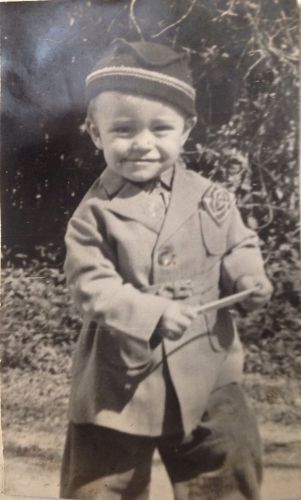
Lost & Found
Help reunite mystery or 'orphan' photos that have lost their families.
Photos with the names and dates lost in history. AncientFaces has been reuniting mystery and orphan photos with their families since we began in 2000.
This 'Lost & Found' collection is of photos foun... 
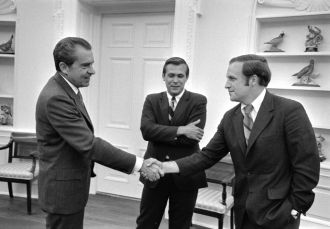
Political
Original photos of the politicians and political events throughout the past few centuries.
Welcome to a collection of photographs that document the fascinating history of politics. From democracies to monarchies, communism to fascism, and everything in between, this page captures the divers... 
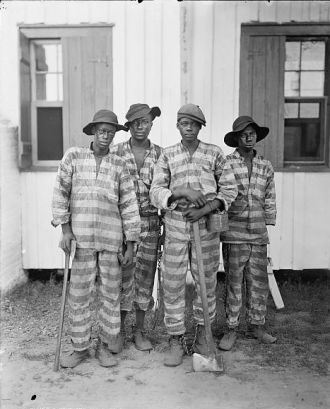
Notorious
The people and places that live on in our memories - not for good reasons but because of how they shocked and saddened.
Images of serial killers, mass murderers, despots and dictators, prisons, and the victims of these horrors. These people & places live on in infamy in our history.
There are the notorious killers: Th... 
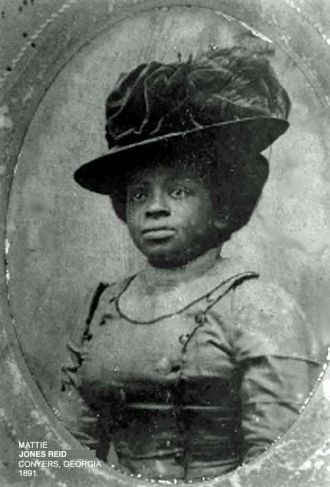
1800s
The 1800s where the end of the industrial revolution and the birth of scientists.
The Industrial Revolution began around 1760 and ran through the 1840's. Then began the birth of the profession of science. Louis Pasteur, Charles Darwin, Michael Faraday, Thomas Edison, and Nikola Te... 
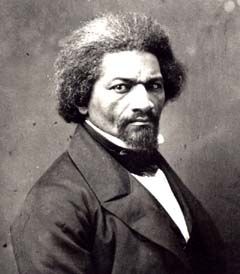
African Americans
See the faces of just some of the many African Americans who have contributed to building the United States into the country it is today.
African Americans in the early history of the United States had an extremely difficult start as immigrants. Having been primarily forced to immigrate to a new continent, African Americans worked throu... 
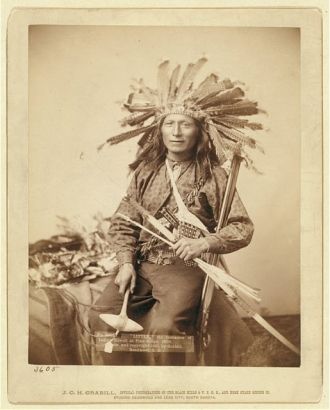
Native Americans
Images of the Native American people - the tribes, their dress, and their lifestyles. We honor and celebrate Native American history with this collection of historic photos.
The best way to understand the people who first inhabited North America, Native Americans, is through their own words. The following quotes contain some of the wisdom passed down through generations o... 
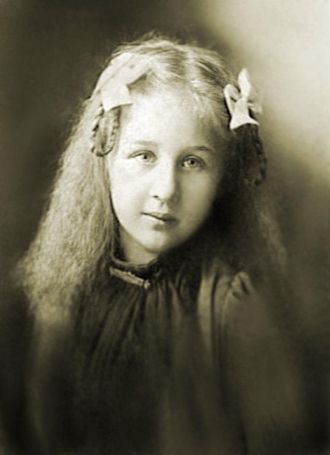
Popular Photos
These historical photos have generated quite the buzz!
This collection of historical photos has got people talking. These photos - either because of the subject and/or the story - have generated a lot of comments among the community. What do you have to s... 
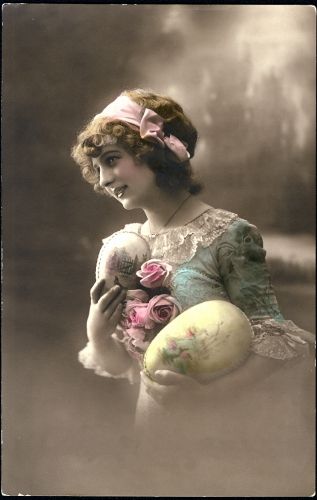
Fashion
Discover how fashion has changed over the years with this collection of photos.
Fashion styles & vintage clothing throughout the decades that will inspire, make you wish for those times again, or may make you ask "What were they thinking"?
Clothing styles have obviously changed ... 
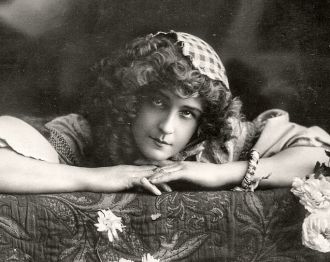
Celebrities
Discover the lives and legacies of notable celebrities from the past, like Bette Davis and John Wayne, by browsing photographs of them in their prime.
The lasting impact of celebrities from the past cannot be denied; they continue to be an essential part of our cultural history. Through their talent, charisma, and unique personalities, they entertai...
AncientFaces
This account is shared by Community Support (Kathy Pinna & Daniel Pinna & Lizzie Kunde) so we can quickly answer any questions you might have.
Please reach out and message us here if you have any questions, feedback, requests to merge biographies, or just want to say hi!
2020 marks 20 years since the inception of AncientFaces. We are the same team who began this community so long ago. Over the years it feels, at least to us, that our family has expanded to include so many. Thank you!
2020 marks 20 years since the inception of AncientFaces. We are the same team who began this community so long ago. Over the years it feels, at least to us, that our family has expanded to include so many. Thank you!

